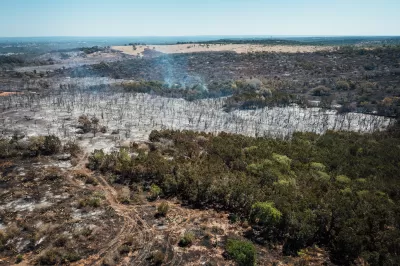Sprawl in and around Austin is contributing to growing wildfire risks, and local officials worry about a lack of public awareness of the issue.

Fire risk is making its way from California to Texas along with tech companies and workers looking for more affordable housing, writes Patric Sisson in Bloomberg CityLab. As developers build more communities in the Austin suburbs to accommodate the growing population, neighborhood sprawl is increasingly encroaching on local forests.
“In general, the wildfire peril in Texas can’t compare to that in California, which is among the highest in the world, said Sam Carter, founding principal of Resilient Cities Catalyst.” But Austin city council member Alison Alter says “The fire risk in Austin is pretty serious, and I don’t think there’s a level of awareness that there is in California.” According to the article, over one third of Austin is at ‘high risk’ of fire.
Austin has experienced its own deadly fires in the past: “In 2011, nearly 1,700 buildings were destroyed when a wildfire tindered by downed power lines raced through drought-parched subdivisions in Bastrop County, southeast of Austin. More than 30,000 acres burned and two people were killed.” Conditions can be made worse by other natural disasters such as ice storms and deep freezes like the one that damaged infrastructure and felled trees and power lines across Texas in 2021.
“Creating a more fire-resilient central Texas would require a holistic approach and a lot of coordination between property owners: Unlike California, with its massive stock of state and national forests preserves and parks, 90% of Texas land is privately owned.” And while there is little optimism that builders will stop building, some cities are developing fire protection plans and coordinating fire response policies to prepare for future blazes.
FULL STORY: One More Thing Moving From California to Texas: Wildfire Risk

Study: Maui’s Plan to Convert Vacation Rentals to Long-Term Housing Could Cause Nearly $1 Billion Economic Loss
The plan would reduce visitor accommodation by 25,% resulting in 1,900 jobs lost.

North Texas Transit Leaders Tout Benefits of TOD for Growing Region
At a summit focused on transit-oriented development, policymakers discussed how North Texas’ expanded light rail system can serve as a tool for economic growth.

Why Should We Subsidize Public Transportation?
Many public transit agencies face financial stress due to rising costs, declining fare revenue, and declining subsidies. Transit advocates must provide a strong business case for increasing public transit funding.

How to Make US Trains Faster
Changes to boarding platforms and a switch to electric trains could improve U.S. passenger rail service without the added cost of high-speed rail.

Columbia’s Revitalized ‘Loop’ Is a Hub for Local Entrepreneurs
A focus on small businesses is helping a commercial corridor in Columbia, Missouri thrive.

Invasive Insect Threatens Minnesota’s Ash Forests
The Emerald Ash Borer is a rapidly spreading invasive pest threatening Minnesota’s ash trees, and homeowners are encouraged to plant diverse replacement species, avoid moving ash firewood, and monitor for signs of infestation.
Urban Design for Planners 1: Software Tools
This six-course series explores essential urban design concepts using open source software and equips planners with the tools they need to participate fully in the urban design process.
Planning for Universal Design
Learn the tools for implementing Universal Design in planning regulations.
City of Santa Clarita
Ascent Environmental
Institute for Housing and Urban Development Studies (IHS)
City of Grandview
Harvard GSD Executive Education
Toledo-Lucas County Plan Commissions
Salt Lake City
NYU Wagner Graduate School of Public Service



























